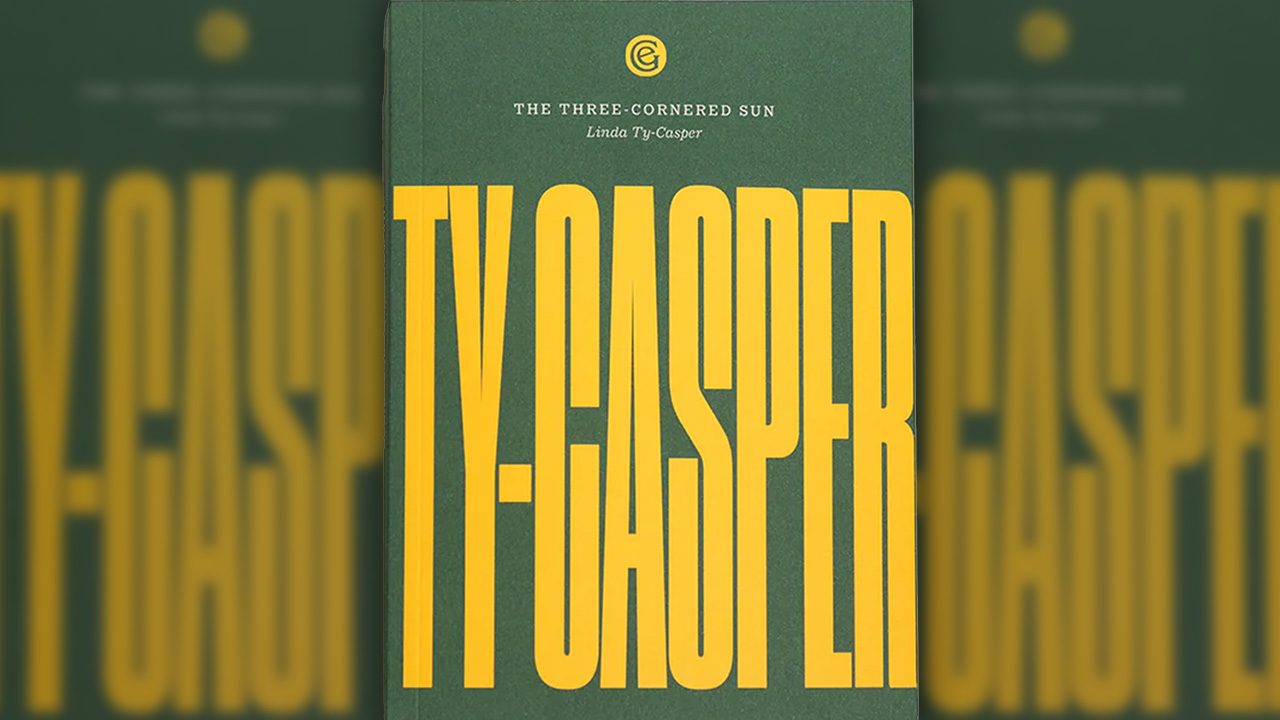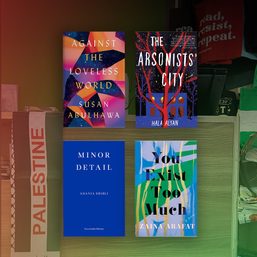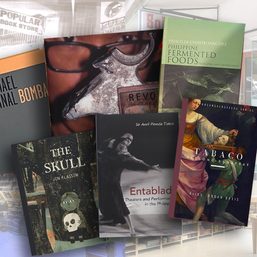SUMMARY
This is AI generated summarization, which may have errors. For context, always refer to the full article.

MANILA, Philippines – “I realized that there’s so much Philippine literature that you just can’t find in bookshops or even through secondhand sellers online, and during the height of the pandemic, access to libraries was near impossible. So where do these books go to be found? I decided to unearth some of these books, one at a time, and bring them to life,” said Exploding Galaxies publisher Mara Coson, when asked about how the publishing house came to be.
Rediscovering near-forgotten works of contemporary Philippine fiction, Exploding Galaxies debuted in June last year, with its maiden title: a reprint of Wilfrido Nolledo’s 1970 novel But for the Lovers, about a diverse cast of characters leading precarious lives in war-time Manila, forged through a language lush and unflinching in equal measure.
What succeeds this debut title is another work set under occupation, Linda Ty-Casper’s The Three-Cornered Sun, released in a vibrant combination of yellow and green. The novel, which follows a family trying to survive a Philippines that is on the cusp of liberation, is ten years in the making, which speaks of the toil that Ty-Casper has devoted to rendering the book’s expansive world.
Much like Ty-Casper’s previous writing, The Three-Cornered Sun illuminates for how it pumps new life into a pivotal juncture in our nation’s past and conceives an unforgiving space reflecting where our present is and where it can go. And what a fitting irony that The Three-Cornered Sun sees the light of day at a time when our history is under threat, when the empire tightens its grip on us.
Framed in this context, the novel finds its staying power.
“I didn’t think there were any new readers for it. I’ve never been widely read, for some reason, but I persisted in writing about us – to fill the absence of our side,” Ty-Casper writes in the preface to the latest edition.
Hopefully, the novel reaches a readership far broader than what it has gained since its first release in 1979, and that its burning message, which perseveres against the ravages of time and literary decay, simply won’t slip through the cracks.
I caught up with Coson and managing editor Sam Marcelo to talk about the odyssey to reviving the underseen literary gem, a heartwarming meetup with the author in Massachusetts, and building ways forward for local publishing.
Out of all Ty-Casper’s books, what made you gravitate towards The Three-Cornered Sun?
Mara Coson: To me, Linda Ty-Casper is incontestably among our greatest Filipino writers. I think we should be seeing and reading all of her books! But I started with The Three-Cornered Sun because it opened up time and a world for me, particularly the Philippine revolution of 1896, a history I had studied when I was younger but never actually felt. Linda has a very powerful way of making you feel you were right there. In an interview decades ago, she said, “But with me the details are part of the story. It’s part of what’s happening. In fact, a lot of my research never even gets into the story. It just reassures me that this is the way that guy stands or this is the way they climb up that hill, and that it’s cool, that the sun is somewhere out there over the [South] China Sea and they’re over here on this ridge. I have to make sure that when they take a carretela from Nuñez Mendez at this time of night that they’ll reach the place by morning.” It took her ten years to write this novel, and all that effort to rebuild a particular moment in history is really incredible.
How did you approach Ty-Casper for the reprint? Was it harder this time around to secure the rights to republish the book, as compared to Nolledo’s novel?
Mara Coson: I did a good amount of internet sleuthing! I had no idea how to contact Linda Ty-Casper and eventually I chanced upon her daughter Kristina’s email address on the university website where she works and emailed her out of the blue! That’s how it all started and she connected me to her mother, Linda Ty-Casper. They’ve been really great to work with, and I’m so proud to be publishing this book. It is never easy to secure rights, or to even find these writers, but as a publisher, that’s both a joy and a challenge for finding these books. No matter how long it takes!
I’ve learned that you met the author in Massachusetts last year. What was that visit like?
Mara Coson: She lives about half an hour away from Boston, in Framingham, and we had a lovely afternoon over hot chocolate talking about her family, literature, time, and the birds outside her window. Moments like that make publishing these books all worth it! It’s heartwarming to be given the trust and responsibility to carry on what a writer has made and hoped would outlive them.
Can you talk more about your selection process? How long does it take for the team to decide on what you’re going to reprint next?
Mara Coson: There are plenty of books out there that deserve to be republished. We encounter them through our own reading and through the suggestions of our readers, friends, and supporters. There are people excited to see some of their favorite books republished again. The process is never the same for each book. Sometimes we discover titles that are about to be published by other presses, which to me is just as great for the books. But sometimes, the writers have long gone and there’s no way to reach them, so we unfortunately don’t get to republish those (and will likely stay in limbo until they enter the public domain). Selecting is the easy part as decisions can almost be instant – there are many, many “must-reads,” and for us when we choose, there is a connection with certain work that I feel but can’t describe yet. Maybe I might be able to speak about this more precisely five or ten books down the line!
Are there any significant changes in terms of the book’s content, style, etc. during the editing process?
Sam Marcelo: The stylistic changes to The Three-Cornered Sun were minor, such as adding Oxford commas, replacing ellipses with spaced periods, and setting “foreign” words in roman instead of italics, in accordance with The Chicago Manual of Style, which is the house style of Exploding Galaxies.
We hope the tweaks improve the reading experience. For example, on page 181, Blas lets loose a couple of Diablos! The cuss words pop off the page more – pack a harder punch – because ordinary words like, say, pandan are no longer italicized as they were in the previous edition. There’s an entire discussion about code-switching in copyediting circles, when to use italics and when not to – that’s the kind of conversation we had. Linda Ty-Casper was very open to these changes and gave us her blessing.
We’ve been lucky in that the authors and the estates we’ve worked with are clear about what they want and how much we can change: that kind of clarity is crucial. Whatever changes we make have to serve the author. If they’re happy, we’re happy.
Content-wise, we are ecstatic that the Exploding Galaxies edition has a new preface by Linda herself and a new foreword by Manuel L. Quezon III. They’re written in such different registers. Linda’s text is so lovely and so personal: she talks about her grandmother (her Nanay) and her reasons for writing The Three-Cornered Sun. Manolo, on the other hand, gives the historical context of the novel in a meaty discussion of, as he puts it, “not just the era in which it was set, but what preceded it.”
It’s these additional essays, I think, that we can call “significant changes” that add value to the Exploding Galaxies edition of The Three-Cornered Sun.
I noticed that the book size is different from the standard paperback. What’s the idea behind this?
Mara Coson: I wanted a book that readers could really enjoy not just reading, but holding, feeling, and spending time with. I admit as a first-time publisher I was focused more on the production of the book than the efficiencies of standard dimensions.
Do you already have a title written in Filipino or other Philippine languages in the lineup, or at least considering it?
Mara Coson: Yes, definitely. Our first few books are in English, but we’ve always planned to republish books written in Tagalog, Cebuano, and other languages. We’re hoping to release these titles as twin publications – an edition in the original language and an edition translated into English some time in 2025.
What does Exploding Galaxies want to achieve in the long run, and what are your hopes for local publishing?
Mara Coson: At Exploding Galaxies, we want to help make a wide range of great Filipino writing available on shelves everywhere. It’s not a lonely journey because there are some fantastic presses out there that are doing just that. Savage Mind in Bicol has such a strong program of publishing Bikolano books, and there’s also a lot of important work done by Vibal Publishing, Everything’s Fine, Good Intentions Books, Gantala Press, Kasingkasing Press, Archivo 1984, university presses, and a lot more than I can write down here. It’s quite a moment for Filipino literature, and we’re happy to even have a small part in it. – Rappler.com
Add a comment
How does this make you feel?




There are no comments yet. Add your comment to start the conversation.